by Susan Tracey, 1978 Hantsport High School Graduate for a Grade XII history project at Windsor.
The structure now situated at 45 William Street, Hantsport was built in the 1850’s. The building underwent many changes through the years to keep in time with the changing characteristics of the town. This structure alone reveals the degree of activity in the town, through a period of over one hundred years.
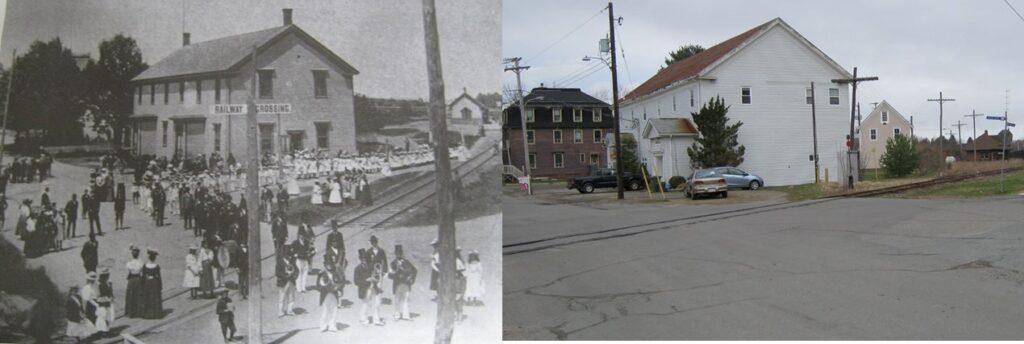
The following is a copy of the Deed conveying the land to the people responsible for erecting the building.
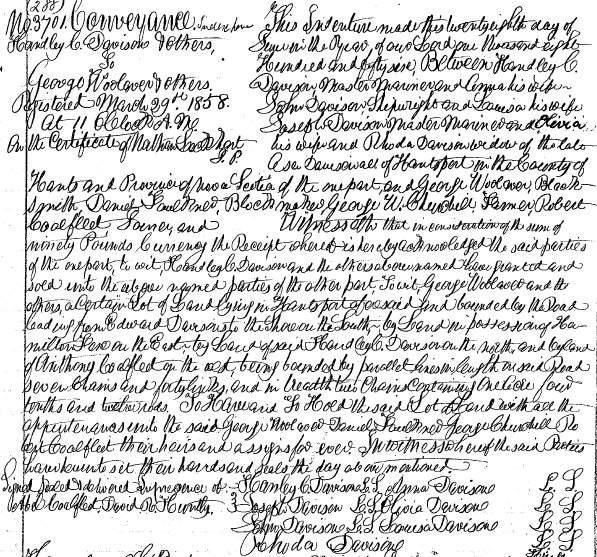 | Conveyance…Between Handley C. Davison (Master Mariner) and Anna his wife; John Davison (Shipwright) and Louisa his wife; Joseph Davison (Master Mariner) and Olivia his wife; and Rhoda Davison, widow of the late Asa Davison all of Hantsport, of the one part and George Woolaver (Blacksmith); Daniel Faulkner (Blockmaker); George W. Churchill (Farmer); and Robert Coalfleet (Joiner) … made 28 June 1856… sum of £90 … bounded by the Road leading from Edward Davison’s to the Shore on the South—by Land in possession of Hamilton Fox on the East — by land of said Handley C. Davison on the north, and by land of Anthony Coalfleet on the west, being bounded by parallel lines in length on said Road 7 chains and 40 links, and in breadth 2 chains, containing one acre four tenths and twelve rods. |
With the purchase of this land, these men set forth constructing a building for the purpose of manufacturing ships’ parts. With their knowledge of shipbuilding, these men were able to construct their building without center supports. The ceiling was made like the hull of a ship with large arches as the means of support rather than pillars that were common at this time. This was necessary as a large open space was needed to draw and cut out patterns. The upper section of the building was occupied by a sail loft in which ship’s sails were cut and sewn. The lower section contained a pattern and block shop which manufactured keels and pulleys for ships. This was known as Faulkner’s Block Factory. It was acquired on October 5, 1862 by Ezra Churchill who continued the business in connection with his shipyard.
When the railway went through Hantsport in the 1860’s the Churchill Block Factory, which it was now called, lay partly in its path. The end of the factory was cut off and moved across to Foundry Road, where it was converted into a home. In 1946 that property was purchased by the Gypsum Company and once more the house was moved, this time to a different location on William Street.
A steam carriage factory may have been located in the Churchill Block Factory circa 1870.
For a period of time, circa 1880’s the upstairs of the building housed the Hantsport furniture factory under the name of North’s and Porter’s. Some of the products manufactured, were as described below.
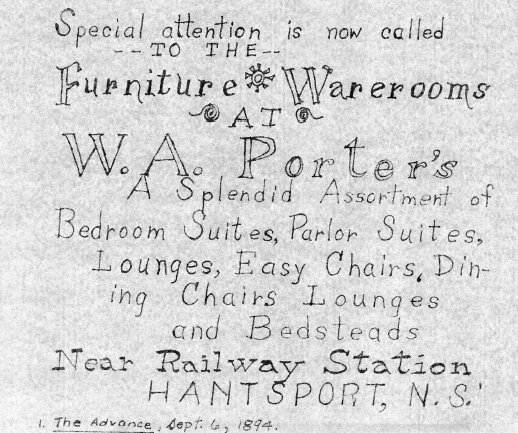
“The furniture factory didn’t last long because they made things too good and the Windsor furniture factory had better salesmen.” 1 Jessie Borden
The building was converted into Churchill Hall which served the community for various events.
The hall consisted of a large room with a stage at one end. The front of the small stage was bordered with approximately a dozen gas lamps. These lamps had reflectors to prevent the light from shining in the eyes of the audience and to cast a light on the stage. Lamps above the windows, along the side walls, lighted the remainder of the hall. These small gas lamps had to be cleaned after every use.
In back of the stage there were steps which led up to two rooms where men and women could change and put on makeup. The floor of the building; consisting of wide rough boards, supported a large coal stove.
At this time there was a poster on the building advertising a Pedestrian Tournament which was to be held on July 1, 1880. Mr. William Leggett the Canadian Champion “heel and toe” walker was challenging anyone who wished to compete. 4 John Harvie
A great many concerts of various types were held in the hall, especially during the summer months. One or two school plays were held each year during the time Mr. B. Silver served the town as Principal of the School. The plays that were acted by the younger children were based on fairy tales, such as “Cinderella” and “Hansel and Gretel”. The school also held concerts for which it always received a good turnout. 7 Marguerite Lawrence
Mr. Herbert Mitchner, a resident of Hantsport, lent his talent to many shows. “He was a natural comedian and could have become a star of minstrel shows.” 7 Marguerite Lawrence
He was among those who arranged concerts in the summer when people came home. These received the same support as the school concerts because most people had relatives taking part. The following are examples of an advertisement and a programme.
“The Cantata “ A Dream in Fairyland” will be presented in Churchill’s Hall tonight, with new scenic features. A large number of the little folk will take part. All should hear them. – The Advance, Sept. 6, 1894.
The Dominion Day concert in the evening in Churchill’s Hall was well patronized and at 10 and 15 cents admission yielded $46.59 . Following is the programme – Newspaper scrapbook, July, 1898.
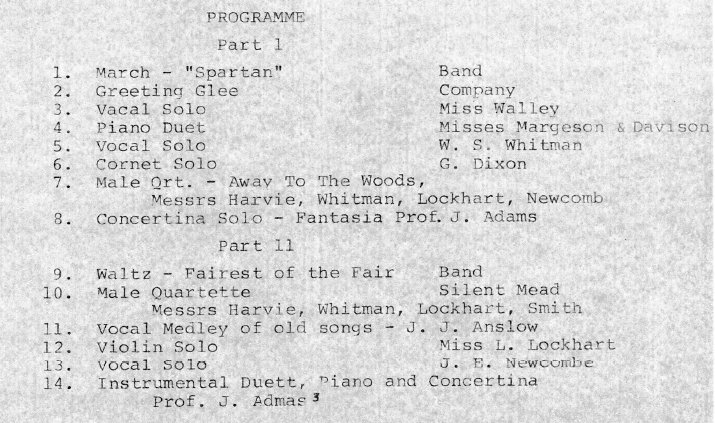
Many travelling shows such as medicine and minstrel shows performed in the hall. The medicine shows were designated by this name because of their reputation of “always selling something that would cure everything” They often had a machine to show pictures before going on stage to perform.
The Price Webber American Company came from Boston once a year and put on simple plays of which one was “East Wind”. They also had magic acts, or sleight of hand which it was called at that time, singing, dancing, gave recitations and told jokes. The people who attended these thought they were wonderful and through the years got to know Mr. Webber and his wife very well.
“The last show was pathetic.” 7 Marguerite Lawrence Mrs. Webber being in her sixties attempted to take the part of a young boy in one of their plays. The audience found this rather amusing but their feelings were not shared by the Webbers, who never returned.
As common as these shows, were the little penniless boys at the door trying to sneak in. Only the more daring attempted although many others longed to do so. 7 Marguerite Lawrence
During late 1908, early 1909, the hall was purchased by the Oddfellows Lodge of Hantsport. Around this time Don Lyons made his contribution to the hall. He painted heavy canvas screens to be used as props on stage. One side was painted green like a garden and the other, when the screens were turned around, was like a special room. He used the same flower design as he did in the Churchill house, known as “The Cedars”. 3 Rhoda Frizzle
The Hall was used as a meeting place where many political and local meetings were held. Various lodges and organizations met above the hall for many years. Tea meetings also took place, where fancy work was shown. Suppers and Christmas Sales were held by different churches.
A supper was served to the Parrsboro ball team between the hall and the railway tracks, where tables with awnings over them had been set up. The team had sailed over on the Schooner to take part in the first of July festivities and was to sail home on the next tide,
The occasional dance was held in the hall. The first were old-fashioned and square dances. There was great disapproval felt in the hearts of the people when the dances first began. There was a meeting of the Deacons to see if the names of two girls would remain on the church list because they danced. Most girls were not allowed to go to the dances. This opposing feeling weakened and dances were held regularly every week. At one time the young men paid fifty cents each with which they hired a pianist for two dollars and paid four dollars rent for the hall a night. 9 Laurie Pattison
During the same time at which the hall was present in the building, a small portion of the end, toward the railway track, had been partitioned off and was occupied by the Hantsport Post Office.
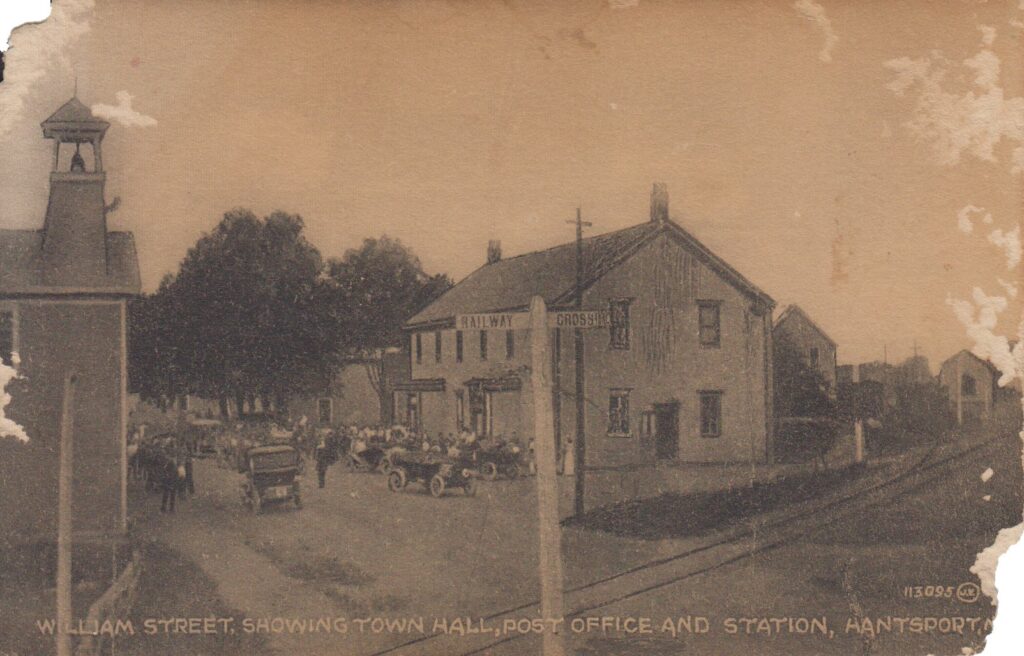
The entrance at the end of the building led into a small waiting room. To one side of the door was an area sheathed for the storage of coal; to the other side, a window. Opposite the door were the mail boxes which served as a partition between the waiting room and the working area. The working area contained three windows which provided sufficient lighting on most days. The floors of both areas were considered “wretched and would almost blister your feet”. 8 Helen Patten
They were board floors, covered with a heavy tar paper and a coat of paint.
The working area contained a small coal stove which supplied sufficient heat, although the room was drafty. Besides the stove, there was a roll-top desk, an office chair, a bench, and a stand and basin; the workers were deprived of washroom facilities.
There were 149 or 159 mail boxes which consisted of a numbered glass window. Through this, you could see your mail but couldn’t get it.
Prior to the closing of this Post Office, approximately twenty-four combination boxes were installed. On one side of the boxes was a wicket where such business as parcel post was done; registered mail, the local paper for subscribers, and general delivery received. While the mail was being sorted, the shutters on the wicket were closed. On the other side of the boxes was the money order wicket, This was a half-oval window that was raised and held up with a plug, letting it down when business was completed. Postal notes were available for twenty cents to five dollars in value at one time, but could only be sent in Canada. Postage stamps were purchased to make up the odd cents. During war time, the Post Office sold War Savings Stamps. 8 Helen Patten
It was the style for the local people to go to the station and wait for the train to come in; then to the Post Office for their mail. Everyone waited in the little room until the mail was sorted. Once the wicket was opened, they lined up and got their mail. Some people were noisy during their wait and were ordered out by the Post Mistress. 8 Helen Patten
The train came from Halifax in the morning and returned to Hantsport in the late afternoon on its way back to Halifax. “If the train was late, you stayed until it came.” The Hantsport Post Office did not rely totally on the train for mail delivery. “Capt. Benjamin Nason, at the age of 90 years… had the contract for conveying the mails to and from Hantsport three times a week.” – Newspaper scrapbook, Apr., 1906
The Post Office employed two workers. For many years, Mr. Riley worked as Post Master and Mrs. Riley acted as his helper until she became Post Mistress, helped by her daughter.
The Rileys lived in the part of the building which was separated and moved when the railway went through. Later, Mrs. Riley was helped by Gertrude Folker, then by Miss Jessie Borden during the summer of 1923. The position was filled, for the last time, by Miss Helen Patten in July, 1924.
Mrs. Riley passed away and was replaced by Hugh Rolfe. At this time, the Post Office was “real old-fashioned…a wreck…run-down.” The new Post Office was needed desperately by the time the little Post Office closed on July 1, 1929.
Shortly after Hantsport was blessed with electric lights, July 7, 1914, Mr. Black opened a movie house which replaced the hall. Built at the back of the room was a two- story camera booth. The lower part of the booth contained a desk and films. Steps led up to the camera. The movie machine was considered to be “old-fashioned even at the time. It had to be cranked by hand, you got accustomed to one hand on the lights and the other turning it, just watching to see that you got the proper lighting. It came naturally after.” 9 Laurie Pattison
The booth was encased in metal for fire protection purposes. It was surrounded with approximately 225 chairs of which most were later replaced by fold-back seats.
The movie house ran Tuesdays, Thursdays and Saturday nights; the shows usual lasting for two hours starting at seven-thirty. The main feature was shown each night, after a short news strip. Serials were played, “to get you hooked” 12 Minnie Taylor “Poor Pauline” was one during which the lights would be turned on half-way through the film. For ten to fifteen minutes, there would be a sing-a-long, where a little white ball would bounce across the screen, on top of the words. The first films were silent, for which a pianist was employed. Pearl Dixon and Mrs. Fred Lane were employed for a rate of two dollars a night in 1920. There was difficulty in finding people to play as the job required a great deal of concentration to change the style of the music, with the change in scenes of the movies.
Working for Black, Ervin Pattison was manager and his brother, Laurie, ticket taker. Laurie graduated to manager when Ervin went to war. Mr. Mason bought out Black, and Laurie Pattison took over the business in 1920 for two years. It was believed that the movie house was given the name of “The Empire Theatre” by the Oddfellows as they were great supporters of the monarch. During Mr. Pattison’s running of the theatre, “it was not a financial success”. 9 Laurie Pattison
A rent of five dollars a night was paid, to the Oddfellows, for the room and machine.
Many factors contributed to the lack of success, one being the age groups of the town’s people. The young people left Hantsport; only the older and very young remained. The older people could not afford to attend the movies, thus the young could not go either. “The church was very much against the movies and often spoke of them in their sermons. We had to work against these people and almost everyone went to church.” 9 Laurie Pattison

In time, it was accepted more. The radio was soon to come in and take the place of silent movies, but the town’s industry did not hinder the theatre financially. Murray’s Mill was the only existing industry at this time and few were employed. For this reason, there wasn’t any competition for employees.
The theatre was taken over in 1922 by Ian Pulsifer who still ran the silent movies and a while later by Blake Benjamin when the “talkies” were popular. Mr. Benjamin renamed the theatre, “York Theatre”. Mr. Gertridge had his turn and was followed by Albert Boyd in June, 1952. “The talkies were received with wonder”, 12 Minnie Taylor as the movies were now accepted. The well-known shows “Rebecca of Sunnybrook Farm” and “Anne of Green Gables” had high attendances. When the latter came, “everybody went and we were so annoyed because in the school room, they had an American flag.” 1 Jessie Borden

For five years, Mr. Boyd acted as Manager and at this time much renovation was done to improve the very bad conditions of the theatre. Advertising of the theatre was done in much the same manner as the movie house had been advertised. In 1920 the local paper reserved the last page for the theatre. A bulletin board with a poster of the feature film often rested in the snowbanks of the winter months. In 1955, the local paper had been replaced by the ‘Hants Journal’ and a bulletin board of the town’s was used.
Until, approximately, the last eighteen months of Mr. Boyd’s management the Theatre possessed a good business with high attendance. Waldo Munroe took over the theatre in 1957 but it only survived for a couple of years. There were many interpretations for the theatre’s decline in activeness.
The Windsor Theatre had priority over the area, including Hantsport for ordering films. If the York Theatre ordered a film which Windsor hadn’t had, they could cancel the order. “It closed with the introduction of television.” 6 John Lawrence People could now stay home and watch movies rather than go the theatre. “They petered out, nobody went. Anybody who was anybody was playing cards; if you were in with society. . . It died a natural death and nobody missed it when it closed.” 1 Jessie Borden
“I hated to see that old theatre go. We went when we had any money. In the end the older people didn’t like the mess and they couldn’t have hired me to go again.” 12 Minnie Taylor
The fact that there were other theatres close to Hantsport gave the people a feeling of security knowing that if they wanted to go to see a movie at a theatre they could. “You could just go to the movies in Windsor.” 7 Marguerite Lawrence
Had these other theatres not been so accessible, the town’s people and those from the surrounding countryside may have patronized the York Theatre more; but this probably would just have prolonged its closing?
Many lodges and organizations met in the upper part of the structure, where the sail loft and furniture factory had once been. Poyntz Lodge, the Hantsport branch of the Mason’s Lodge moved into the center area on January 1, 1881. 11 Bill Stevens
Around this time the Order of Foresters were meeting in another section of the upstairs. This was a fraternal organization for the purpose of life insurance but died, itself, after a short period of time. At this same time, The Sons of Temperance were meeting here. The Poyntz Lodge closed in 1896.
The Oddfellows Lodge took the building into their possession in the latter part of the year 1908 or early 1909 and met there. 5 K. M. Hyson
Poyntz Lodge re-opened in 1920 and purchased the building around this time. The Oddfellows Lodge moved out in the early 1960’s due to poor conditions of their rented part of the building. The York Club consisting of five members acquired the building in August, 1969 for the sum of $3,300. In April, 1971, the final purchase was made to the present owner. The Keyes Fibre Local 576 Union received the structure for $5,000. For a while they used the building for storage, during which it received a twelve foot extension on the up-town end.
This building with its many owners from the first, Faulkner’s Block Factory to the last, Keyes Fibre Union must have many pleasant memories as must all the people who were in anyway connected with its past. It was truly for many years the activity center of Hantsport.
BIBLIOGRAPHY
Personal Correspondence; Personal and Oral Interviews
1. Borden, Jessie, personal interview, Hantsport, Oct. 1978 with the author.
2. Boyd, Albert, personal interview, Hantsport, Nov. 1978 with the author.
3. Frizzle, Rhoda, personal interview, Hantsport, Nov. 11, 1978, with the author.
4. Harvie, John, oral interview, Hantsport, Nov., 1978, with the author.
5. Hyson, K. M. , oral interview, Hantsport, Nov., 1978, with the author.
6. Lawrence, John F., oral interview, Hantsport, Nov. 6, 1978, with the author.
7. Lawrence, Marguerite, personal interview, Hantsport, Nov. 6, 1978, with the author.
8. Patten, Helen, personal interview, Hantsport, Nov. 9 , 1978 , with the author.
9. Pattison, Laurie, personal interview, Hantsport, Nov. 7, 1878, with the author.
10. Robertson, Allan B. , personal correspondence, Hantsport, Oct. , 1978, to the author.
11. Stevens, Bill, oral interview, Hantsport, Nov. 1978, with the author.
12. Taylor, Minnie, personal interview, Hantsport, Nov. 1978, with the author.
